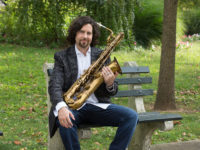Photo from Jos Knaepen/ amsterdamjazzagency.com
by S. Victor Aaron
When I first started the Stacks series last year, I had two formatting rules about it: each artist was to be allotted one paragraph each and there must be at least six albums examined. I’m bending both rules this time, as only five new releases will get a look, and the single long paragraph gets broken up into two, somewhat smaller ones. With one exception, these are 2011 releases, but that exception was made for an record released in the still-recent November time frame because it’s from a living legend who deserves some space on any site that pays homage to jazz. No, we’re not going to be one to act as if this giant doesn’t exist. That rest of the offerings are by emergent names and a couple whose records I’ve even discussed before. Every one is talented as hell: as performers, composers and leaders. Rest assured, the field of really good jazz players is extremely competitive.
Thus, the second volume of Stacks for 2011 is here to keep these wunderkinds from escaping notice. With so many more albums by other highly skilled jazz musicians coming up this year, you can bet your last nickel that we’re not going to stop at Volume 2:
Benjamin Drazen Inner Flights:
Soprano and alto sax specialist Benjamin Drazen is a relative newcomer, and Inner Flights released earlier this week on Posi-Tone Records marks his first foray as a leader on an album. That doesn’t mean he sounds “green,” though. Now here’s where I might say which famous altoist Drezen sounds like, but I’m kind of reluctant to do so because he sounds more like a “little bit of this and a little bit of that.” I will say that he’s more of an old school kind of player who knows how and when to bend a note to squeeze the most soul juice out of it and though he can fly up and down the scales like a real bebopper, he’s more apt to play for the feel than to show off.
For his debut, Drazen went with the tried-and-true quartet format, ably backed up by Jon Davis on piano, Carlo De Rosa on bass and Eric McPherson on drums. In this set of nine songs, Drazen wrote seven of them, and they reveal a real range in his composing: going from the post-bop cooker “Mr. Twilight” to the floating ballad “Prayer For Brothers Gone,” or the urbane “Kickin’ Up Dirt.” But I might like his exercise on making up his own Thelonious Monk tune the best. “Monkish” has all the impishness of a Monk composition with an unmistakable blues and bop-based foundation. Inner Flights gets Benjamin Drazen’s solo career off the ground with a smooth takeoff.
Brian Landrus Quartet Traverse: Baritone sax players tend to get the short shrift in recognition compared to practitioners of the “lighter” saxophones. It’s big, burly sound has more edge in its tone that might be a little gruff to some but that didn’t stop Gerry Mulligan from making some jazz history with it. Luckily, though, there’s still players out there blowing the big horn with all the swing and passion of their forbears. One of those cats is Brian Landrus.
Landrus put out his first record just last year. Forward was covered here and that record was an octet. For Traverse, released March 1, Landrus whittles it down to a quartet, retaining Michael Cain on piano and adding the top-rate Lonnie Plaxico and Billy Hart on bass and drums, respectively. Landrus wrote, or cowrote with Cain, all of the eight songs except for “Body And Soul.” In this lighter arrangement, we get to hear more of Landrus (who also doubles on bass clarinet) and here we discover how much of a tenor player he sounds like; his a cappella piece “Soul And Body” followed by a straight rendition of “Body And Soul” a more feathery sound in his baritone that you don’t hear often, and it’s very enjoyable to hear. “Gnosis,” “Lone,” and “Lydian 4” are also highlights, but there’s no real filler on this record. Traverse is another chapter in the fast-developing career of Brian Landrus. And his third record Capsule is due out in July. Watch out for this guy.
Toots Thielemans European Quartet Live: He’s performed with Benny Goodman, Ella Fitgerald, Charlie Parker, George Shearing, Bill Evans, Paul Simon, Billy Joel and Pat Metheny. Fred Hersch played in his band on his own way up to the top. He’s the whistler in the original Old Spice commercials, and the harmonica on the theme to “Sesame Street,” as well as “The Midnight Cowboy.” He wrote a jazz standard, “Bluesette.” If there’s one harmonica player outside of blues we should talk about, it should be the world’s most famous one: Jean “Toots” Thielemans.
Nearing his 89th birthday, Thielemans had last November released a collection of live performances from 2006-2008, called European Quartet Live. Backed by a trio of Europeans—Karel Boehlee (piano, synthesizer), Hein Van de Geyn (double bass) and Hans van Oosterhout (drums)—this foursome runs through well-known standards and songs closely associated with the grand harmonica player that showcase his graceful, soulful and rich tone. He shows no sign of slowing down as he gives note-perfect deliveries of songs like “I Loves You Porgy,” “‘Round Midnight,” “Theme From Midnight Cowboy” (which features a lovely bass solo by Mr. de Geyn) and of course, “Bluesette.” But even Toots himself is nearly overshadowed by the recording engineer Chris Weeda, who did an outstanding job taping these performances that are virtually studio quality. With so many albums of his to choose from dating back to the mid 50s, a person wanting to build a Thielemans record collection couldn’t fail by starting with European Quartet Live.
Lynne Arriale Convergence: A very proficient mainstream jazz pianist who can swing and caress with equal agility, Lynne Arriale has wracked up acclaim since winning the Great American Piano Competition in 1993. Since then, she has made recordings with such jazz luminaries as Randy Brecker, Steve Davis, Jay Anderson and George Mraz in her band. Last month she issued her ninth album, Convergence (Motéma Music), which features Bill McHenry on tenor sax, Omer Avital on bass and Anthony Pinciotti on drums, yet another powerful combo.
Arriale’s composing skills are on display for six of the songs, ranging from the burner “Convergence” to the tender ballad “For Peace.” For “Dance Of The Rain,” Avital switches to an oud as Pinciotti plays percussion to create a wonderfully exotic, Middle Eastern aesthetic to Arriale’s original. There are covers like on some of the other CD’s mentioned in this article, but Arriale went to the pop and rock realms to find her sources: “Here Comes The Sun” (The Beatles), “Sister Moon” (Sting), “Call Me” (Blondie), “Paint It Black” (The Rolling Stones) and “Something I Can Never Have” (Nine Inch Nails). Though Arriale and Co. provide some fresh arrangements to these tunes, some work better than others; “Sister Moon” and “Something I Can Never Have” work the best (McHenry’s mood modulating performance on the latter is particularly nice). With Convergence, there’s no reason to think that the accolades will stop.
Alexis Cuadrado Noneto Iberico: The last time we visited the bassist Alexis Cuadrado, it was to put an ear on his 2008 release, Puzzles, which we thought showed a rich diversity of styles within jazz. This time, the Brooklyn Jazz Underground co-founder makes a more focused effort. Noneto Iberico (to be released March 15) is jazz that is seasoned with the Spanish flamenco style of his homeland. But as a very accomplished composer and arranger, Cuadrado doesn’t merely mash up flamenco and jazz; he creates nine movements that are intricately conceived and connected, and assembles a nine piece band full of some of NYC’s finest to bring his pieces to life. Brad Shepik (guitar), Loren Stillman (saxophones), Alan Ferber (trombone) and Mark Ferber (drums) are brought back from Puzzles, and are supplemented with Perico Sambeat (saxophones, flute), Avishai Cohen (trumpet, flugelhorn), Dan Tepfer (piano), and Marc Miralta (cajon, percussion).
Though the music is heavily composed, Cuadrado incorporates elements of improvised music that gives the song a looser feel than chamber music, and the flamenco flourishes make it festive. But this isn’t light music; it takes several listens to get inside these songs and fully appreciate what the leader is trying to get across. My favorites are the moody “Te Sigo” and the nifty blend of hard bop and Spanish music contained in “Los Panchitos.” Cuadrado demonstrates with Noneto Iberico that there’s little can’t can’t accomplish musically that he sets his mind to.
- Ivo Perelman, with William Parker + Rashied Ali – ‘Sad Life’ (1996, 2025 reissue) - April 15, 2025
- Nels Cline – ‘Consentrik Quartet’ (2025) - March 31, 2025
- Seth Walker, “Why The Worry,” from ‘Why The Worry,’ (2025): Sneak peek - March 28, 2025




